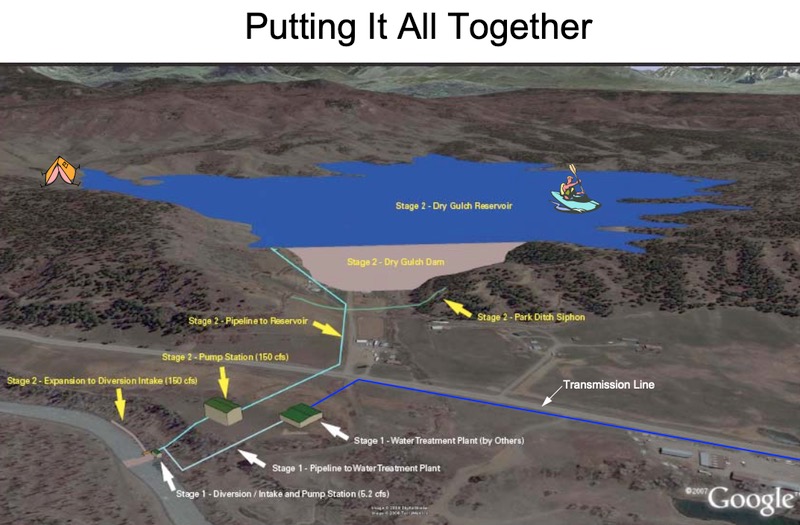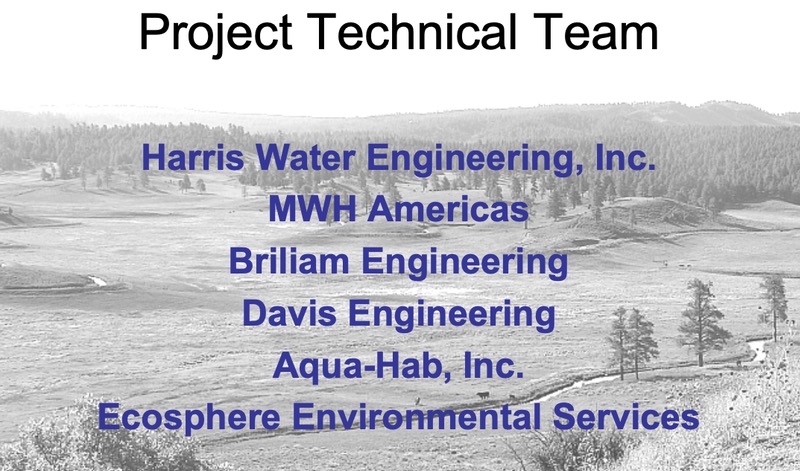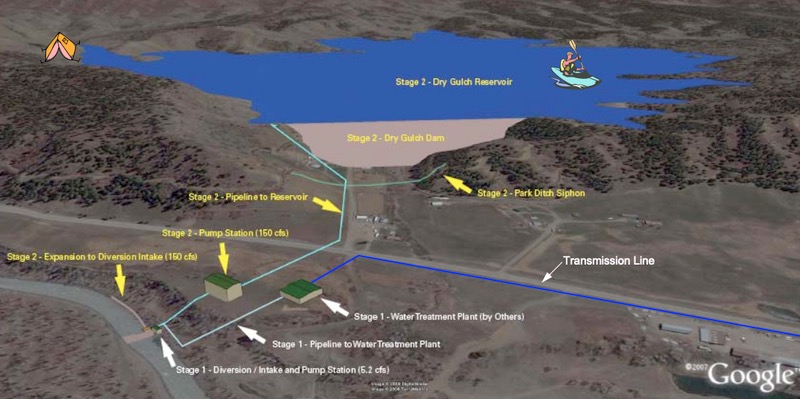Promises were made, in the process of re-negotiating the loan and grant contributed by the Colorado Water Conservation Board (CWCB) back in 2008 — a $9.2 million loan to the customers of Pagosa Area Water and Sanitation District (PAWSD) and a $1 million grant made to the citizens represented by the San Juan Water Conservancy District (SJWCD). That money had been used to purchase about 666 acres in the Dry Gulch valley a couple of miles northeast of downtown Pagosa Springs for what was planned, in 2008, to be a 35,000 acre foot water storage reservoir. The project also included a massive pumping station to draw water from the San Juan River uphill to the proposed reservoir site.

The 2008 purchase agreement also allowed the property sellers — the Weber family — to continue ranching and extracting gravel on the taxpayer-owned property for 15 years, so long as they made lease payments of $1 per year. (That’s not a typo. One dollar per year.) I’m not clear which of the two water districts who share joint ownership of the Dry Gulch property — PAWSD or SJWCD — is entitled to receive and spend the annual lease payment, but maybe that’s not too important.
666 acres were nearly enough land to accommodate the proposed reservoir, but not quite. It was believed, in 2008, that PAWSD and SJWCD would acquire the other parcels needed, by 2010. That has still not happened.
It was also believed (by some) that Pagosa Springs would have begun exhibiting a desperate need for this reservoir by now, and that construction of the new dam might begin this year, 2020. But we were also told the dam would not be built until we actually needed it, and certainly not until we could afford it.
Without the dam and reservoir, we were assured by PAWSD and SJWCD, the Pagosa Springs community would suffer the same fate as the cliff dwellings in Mesa Verde National Park. From a 2009 PAWSD Power Point presentation about Dry Gulch:

Six firms were hired to help define the project, and its likely cost, in 2008-2009…

… and they came up with a $357 million plan for the project that included numerous components:

PAWSD and SJWCD re-negotiated the terms of the CWCB loan and grant in 2016.
As mentioned yesterday in Part One, none of the PAWSD board members who agreed to the 2008 purchase and lease remain on the PAWSD board in 2020, although the lease remains in effect until 2023. None of the top-level PAWSD staff are the same as in 2008. None of the SJWCD board members who had accepted the $1 million CWCB grant remain on that board.
It was a totally-new roomful of board members who gathered at the Lyn Avenue offices on January 23 to hear a Power Point presentation by PAWSD Manager Justin Ramsey. Mr. Ramsey explained that the re-negotiated CWCB agreement cut the annual PAWSD payments on the $9.2 million loan by roughly half, and requires no specific work to be done on the proposed reservoir — by PAWSD or SJWCD — until 2036. Twenty years of breathing room, allowing us to decide whether or not Pagosa Springs wants to become a landscape of abandoned cliff dwellings.
But promises were made, in the re-structuring agreement. PAWSD agreed to keep the reservoir project on its long-range planning radar, and agreed not to build a reservoir anywhere except in Dry Gulch for at least 20 years. PAWSD also agreed not to build a pipeline connecting the West Fork pipeline to its uptown customers in District 1. (Pagosa Lakes.) The West Fork pipeline currently serves only District 2 — which is basically everyone east of, and downhill from, Pagosa Lakes.
SJWCD agreed to take the lead in finding some way to finance the project.
There are “penalties” written into the agreement, if PAWSD or SJWCD violate their promises or try to sell the property. They’re not exactly phrased as “penalties” in the 2016 agreement, but that’s the phrase Mr. Ramsey used during his presentation.
The second half of the meeting focused on the 15-year lease agreement with the Weber family, which includes an option to extend the lease should PAWSD and SJWCD so desire.
We’re listening here to PAWSD board member Paul Hansen:
“One thing I think we can all agree on, right away, is that the gravel operation needs to end. Because if we do build a dam out there, we’re going to need that gravel… we would need the gravel for concrete and stuff like that. I mean, how nice would it be to have it right there on the property… These guys have mined millions of dollars of gravel out of there, that we could have used to build a dam.
“So the intention of this whole thing was to start the dam right away, and use the gravel. But because we delayed it, for obvious reasons, it’s going to be more expensive hauling that gravel in than it would be to use it there. I think we all can agree, immediately, that the gravel operation has to end. There should be surveys done to see if there’s any gravel left there, because that would help us in planning for a dam.”
Mr. Hansen asked if SJWCD had a list of potential project partners? Federal? State? Tribal? Someone who could bankroll the reservoir project? SJWCD chair John Porco assured him that former SJWCD President Rod Proffitt had been in talks with various entities before he resigned in 2018, and perhaps his notes from those talks are available.
Mr. Hansen: “We should have a comprehensive list of potential partners… see if we can find somebody interested in partnering up with us, because — as far as PAWSD is concerned — we can’t afford to build a dam.”
Mr. Porco: “[SJWCD] certainly can’t either. I think the idea all along was that it was not going to be funded locally. There’s just not the money available locally.”
As I mentioned, these two boards are relatively new, and perhaps not fully aware of Dry Gulch history. In fact, “the idea all along” — back in 2008, when the taxpayers bought Dry Gulch — was that new Archuleta County development projects were easily going to pay the lion’s share of the cost for this new reservoir, due to our increasingly desperate need for the water right here in Pagosa Springs.

Read Part Three, on Monday. Have a great weekend.

